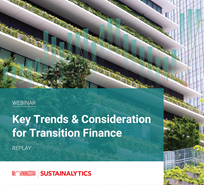Rising Conflict, Responsible Business: What Companies and Investors Need to Know About Operating in High-Risk Areas
In this blog we look at how unstable states are classified and the associated business risk landscape, how companies can manage these risks, and how investors can engage with business operating in conflict-affected areas.
What’s Happening in Sustainable Finance: Green Bond Standards on the Horizon and Much More
In this month’s round up of sustainable finance deals and developments, we look at what the EU Green Bond Standard could mean for the market, innovations in use of proceeds, and the ongoing diversification of industries tapping the market.
Scope 3 Supply Chain Emissions: Five Questions Investors Need to Know
To assess climate-related transition risks, investors should evaluate GHG emissions across portfolio companies’ value chains. In this blog post we’ll answer the key questions investors need to know about supply chain GHG emissions, and why decarbonization of the supply chain is an essential component of an effective climate transition strategy.
What an Impact-Focused Investment Approach Looks Like
Institutional investors and wealth managers increasingly want to consider impact in their investment decisions — for a wide range of reasons. This infographic looks at how impact-focused investing works and how investors can develop an impact-focused investment approach that integrates into their existing strategies, regardless of their motivations.
The Power of Impact: Untapped Potential for Asset Owners, Asset Managers and Wealth Managers
In this blog post, we explore the power of impact as a dimension in investment decision-making and how it can unlock new opportunities and deliver sustainable value for asset owners, asset managers and wealth managers.
Today’s Sustainable Bond Market: Boosting Confidence in Sustainable Bond Issuances
In this article, we examine the kinds of sustainable bonds offered in the market, some of the key regulations being developed in different markets and the current initiatives to improve the quality and credibility of issuances.
Webinar Recap: How Integrating ESG Can Drive Opportunity for Private Companies
Recently, Morningstar Sustainalytics hosted a webinar – ESG in the Lifecycle of a Private Company: How Stakeholder Demands Drive Sustainability in Private Markets – to address some of the questions private companies might have surrounding ESG and how it could impact their business.
Governance in Brief – June 8, 2023
European Parliament approves CSDDD The European Parliament has approved the “Corporate Sustainability Due Diligence Directive.” Under the new rules, companies will be required to identify and address the negative impact of their activities and value chains on human rights and the environment. Additionally, companies will need to implement climate transition plans, and, in the case of companies with more than 1,000 employees, tie directors' variable compensation to target achievement.
What’s Happening in Sustainable Finance: GSSS Market Rebounds, Sovereign Sustainable Debt, and Much More
Get caught up on developments in the global sustainable finance market. This month, we discuss market performance for the first part of the year, continuing scrutiny of SLBs, and the growing group of sovereigns exploring sustainable debt opportunities.
Webinar: EU Green Bond Standards Regulation Implication for Issuers
Sustainalytics invites you to this webinar where we will be discussing the recent regulatory publication on the agreement for the EU Green Bond Standards. We will be highlighting what the implications of these changes are for EU Green Bond Issuers.



















